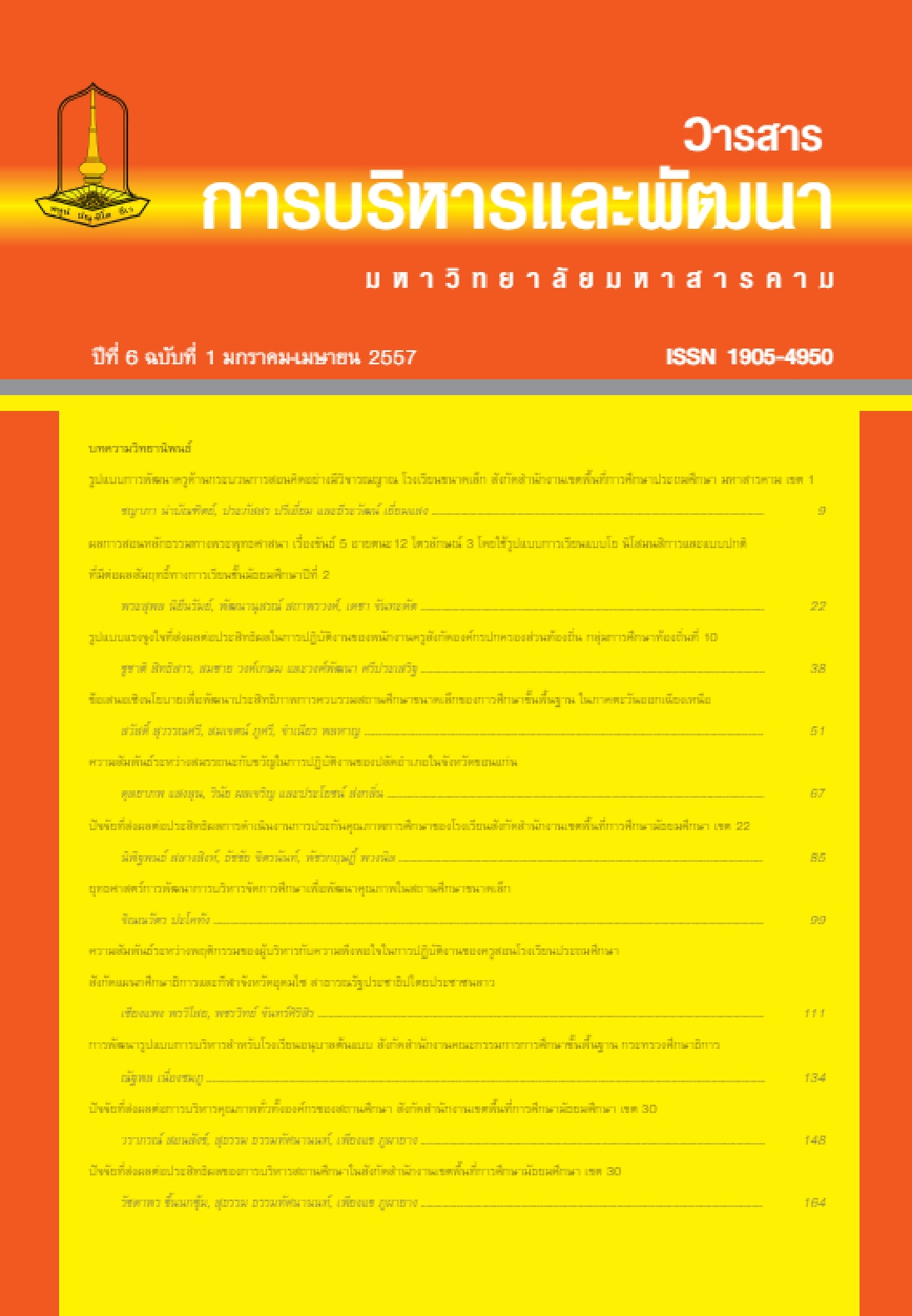A Development of Administrative Model for Prototype Kindergarten.School Under the Office of the Basic Education Commission, the Ministry of Education
Main Article Content
Abstract
This research has the purposes: 1) to study the present condition and the need for management of prototype kindergarten schools attached to Office of the Basic Education Commission, Ministry of Education, 2) to develop management model for of prototype kindergarten schools attached to Office of the Basic Education Commission, Ministry of Education To study the present condition and the need for management of prototype kindergarten schools attached to Office of the Basic Education Commission, Ministry of Education. The researcher adopted a systematic theoretical concept to be the elements of model of management style, consisting of input factors, process and output populations including 183 kindergarten schools. The persons giving the data are school administrators. The instrument used in this research was questionnaire in types of 5 levels. The researcher asked 5 qualified persons to check the values, with the IOC from 0.50 to 1.00, then the researcher measured reliability by method of Kronbak, with the reliability to be equal to 0.94. the researcher analysed by using the average and standard deviation (SD), then analyzed the differences using analysis method of Priority Needs Index (PNI) to determine the index needs to create a pattern. Then the pattern would be brought 7 qualified persons to evaluate appropriateness and possibility. It appeared that there was appropriateness value and possibility at most levels in the two issues.
The research findings appeared that the current condition and needs on the components of the management style still have the same three components, namely input factors, process and output. The model which was developed had the following detail:
Input factors of human resources included staffing to meet the needs and abilities of each individual. The selection was made by means of a variety of material resources included the school had registration for controlling materials and equipment that can inspect and had enough materials and equipment for the needs of the operation. Financial resources included clear financial management and there was arrangement of existing budget to maximize the benefits. Information included development of both short and long term of information system. Information system came from data and facts used in work operation.
Regarding the administrative process, it appeared that administrative processes, included giving opportunity for the personnel to participate in the administration. There were control, inspection, monitoring and evaluation of work operation. learning and teaching process, included the fact that schools arranged activities-scout and girl scout, staying in camps and teachers produced media sufficiently to meet demand. Development process included the fact that students can study and find answers by themselves and curriculum was developed to meet the needs of students. Service included publicizing information about students’ operation. There was coordination and networking of cooperation with the service area.
Regarding productivity, it appeared that developments in several aspects, ncluded physical, emotional, social and intellectual competencies. This included the fact that all students learnt by passing direct experience, making academic achievement to be better and students had physical body proper to their ages and have good habits. The desired characteristics, included bringing the assessment of desired characteristics to improve students’ quality to be efficient and then students would have responsibility in successful working according to the objectives. Expectations about the culture and society, included the acceptance of social change, making to stay in society with happiness and social values of joint agreement of personnel that must comply with in order to achieve the objectives.
Downloads
Article Details
References
นงลักษณ์ เรือนทอง. (2550). รูปแบบการบริหารโรงเรียนที่มีประสิทธิผล. กรุงเทพฯ:มหาวิทยาลัยศิลปากร.
พชร สันทัด. (2554). ภาวะผู้นำการเปลี่ยนแปลงไปสู่ความสำ เร็จของวิสาหกิจขนาดกลางและขนาดย่อม. วารสารคุณภาพชีวิตกับกฏหมาย (ก.ค. – ธ. ค .2554) 106-125
สํานักงานคณะกรรมการการศึกษาขั้นพื้นฐาน. (2555). แนวทางการดําเนินงานขององค์คณะบุคคลและการมีส่วนร่วม. กรุงเทพฯ: โรงพิมพ์ชุมนุมสหกรณการเกษตรแหง
ประเทศไทย
สุจินดา ขจรรุ่งศิลป์ และ ธิดา พิทักษ์สินสุข. (2550). การเรียนรู้ของเด็กปฐมวัยไทย: ตามแนวคิดเรกจิโอ เอมีเลีย. กรุงเทพฯ: สำ นักงานสภาเลขาธิการสภาการศึกษา.
สุวิมล ว่องวาณิช. (2550). การวิจัยประเมินความต้องการจำ เป็น. กรุงเทพมหานคร: สำนักพิมพ์แห่งจุฬาลงกรณ์มหาวิทยาลัย.
Bartol, M. K. and Certo, S.C. (2000). Modern management: Diversity, Quality,Ethics and the Global management. 8th ed. New Jersey: Prentice-Hall.
Barzelay, M. (2001). The New Public Management, California: University of California Press.
Blanchard, K. H. and Johnson, D. E. (1996). Management of Organization Behavior. 7th Ed. Englewood cliffs, NJ: Prentice-Hall.
Caron, E. A., & McLaughlin, M. J. (2002). Indicators of beacons of excellence schools: What do they tell us about collaborative practices? Journal of Educational and Psychological Consultation.
Cassiday, J.S. (2008). A University Laboratory school for the 21st Century. Journal of Evaluation and Research, Volumn 5: 43-48
David, S. (2007). Normal Model and Laboratory schools: Egal Harian education University of central Oklahoma. Journal of Philosophy and history of education. Volumn57: 85-90.


